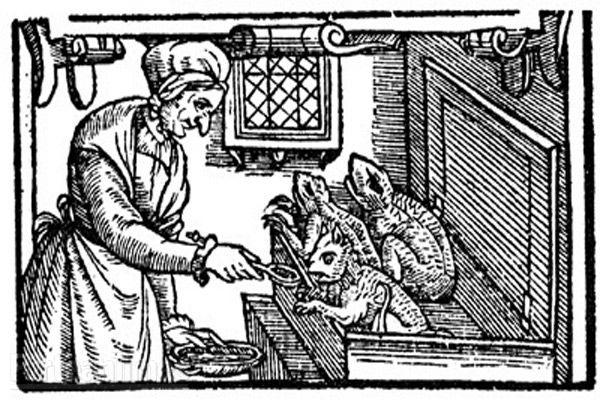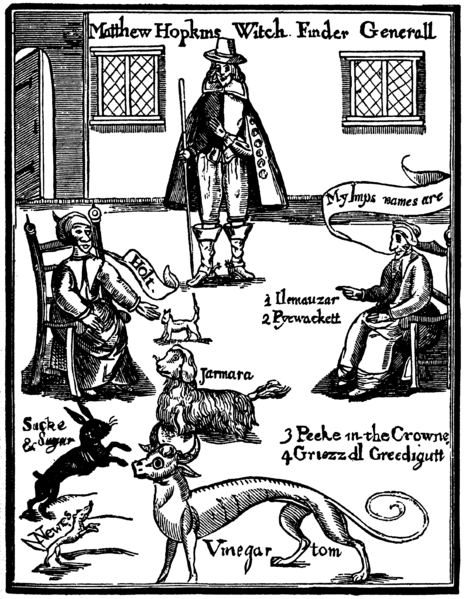How Do You Know What Your Familiar Is
Lead image: The Devil in Britain and America, 1896. Credit: Wellcome Drove. Attribution 4.0 International (CC BY iv.0)
In the history of the witch trials, which saw hundreds of women, men and children beyond England accused of witchcraft related crimes during the 16th and 17th centuries, Liverpool emerges relatively unscathed. It is incommunicable, of class, to know what whispered gossip went on behind airtight doors, never making it to the official record. One instance of Liverpool witchcraft that did make the light of day however concerns Margaret Loy or Ley, and her sis, known every bit Widow Bridge.
In 1667, Margaret plant herself before the authorities accused of witchcraft. She confessed to having been a witch for thirty years since her mother died, before relating a startling tale. When her mother had died, there was precious little to pass on to her daughters: with no wealth or property of note, instead she bequeathed to them her familiars. Margaret and her sis had accepted this unusual inheritance, and they had been in possession of the creatures e'er since.
What happened to Margaret and Widow Span afterwards Margaret made her confession is unclear. Although talk of spirits and witchcraft sound fantastical to our modern minds, confessing to owning a familiar was very common amidst accused witches in England, and the historical record is rife with tales of what these imps got up to. There is no hint of what form these spirits took in the Liverpool case, but from the evidence of confessions elsewhere, it is possible to deduce diverse options.
Familiars, according to those who confessed frequently came to the witch in the form of an animal. The obvious selection was of class the cat, a animate being long associated with witches and witchcraft. Agnes Waterhouse, the start woman to be executed in England for witchcraft in 1566, confessed to owning a cat named Satan that she had been given by her sister. This aptly – or perhaps rashly – named feline was used to kill and injure several people, along with bringing misfortune to those who incurred Agnes' displeasure.

A witch feeding her familiar. Unknown author, Public domain, via Wikimedia Commons
Ferrets were another pop choice. In the St, Osyth Trials in Essex in 1582, Ursula Kempe accused Elizabeth Bennett of keeping a ferret shaped spirit in a pot. This spirit had been used to bewitch both people and cattle, causing death to several people. Alice Chase, some other St. Osyth resident also kept a ferret in a pot: this beast had killed half dozen animals belonging to a human named Hayward. Alice had reputedly rewarded this fine work past giving the spirit some blood to suck. The Edmonton Witch, Elizabeth Sawyer was accused of having white ferrets in her house in 1621, but she denied that they were imps.
Mice and rats likewise appeared in the confessions of accused witches equally they related their crimes to their questioners. In 1645, Elizabeth Harris of Faversham, Kent, confessed that the Devil had visited her 19 years ago in mouse form. He had promised to assist her behave out revenge upon her enemies. Sure enough, a man who had accused her of stealing a pig barbarous ill and wasted abroad until he died. The mouse used Elizabeth's claret to write the covenant between her and the Devil himself. Anne Cade from Great Holland confessed to having 3 mice familiars her mother had given her: their names were James, Prickeare and Robyn. She used them to kill and harm her enemies.
James Device, i of the infamous Pendle Witches, confessed to having been visited by a familiar named Bang-up, who came in the form of a dog. Groovy asked for his soul in substitution for having revenge on anyone he chose. His grandmother, Demdike, was visited by her familiar Tibb in the shape of a dog, who sucked claret from her. The previously mentioned Elizabeth Sawyer was also said to have a canis familiaris familiar. He was called Tom and visited her as either a large black dog, or a small white i. Tom sucked her blood for a quarter of an 60 minutes, simply co-ordinate to Elizabeth this caused her no hurting.
Perchance one of the strangest familiars on tape comes from across the border into Wales. In 1591, the local bailiff got more he bargained for when he decided to put Gwen's powers to the test. When he arrived at her home enervating refreshments, things took a nasty plow when Gwen was manhandled by one of his party. When the potable was produced nevertheless, Gwen had the last express joy – there was a large fly floating in the jug, and however difficult the men, tried information technology couldn't be removed. The fly was so big and behaved in such a strange way in fact that the men were certain this was no ordinary fly, but was in fact Gwen's familiar. This seemed to be confirmed when the homo who pushed Gwen discovered his arm broken – the very one used to push her - and the bailiff's own wife was rendered unable to move her limbs.

Matthew Hopkins, Witchfinder General. Unknown writer, Public domain, via Wikimedia Commons
Another unusual familiar form was recorded on 25 September 1645, when Jane Holt, a widow of Faversham, confessed to existence a witch. Jane related how for the terminal xx years a brute that resembled a hedgehog had visited her a couple of times a month. It sucked at her, causing her hurting. Curiously, the animal was not prickly similar a hedgehog however: when she pushed information technology away, it felt soft similar a cat.
Shape shifting was not unheard of where familiars were concerned. Satan the cat for instance, after consultation with his impoverished mistress, was turned into a toad so that Agnes could sell the wool that the familiar lay on. This same spirit was also seen in the grade of a canis familiaris, terrorising young Agnes Browne and threatening to kill her.
The naming of such spirits varied equally much as the forms they took. Self-styled Witchfinder Full general Matthew Hopkins used the naming of familiars every bit proof of their existence: citing such names as Pyewacket, Grizzel Greedigut and Vinegar Tom, he concluded that no mortal could take invented them. Others however were more mundane, going by names such as John or Nan.
Source: https://www.liverpoolmuseums.org.uk/stories/familiar-spirits-and-devilish-imps
0 Response to "How Do You Know What Your Familiar Is"
Post a Comment